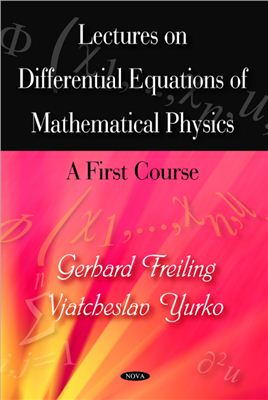Nova Science Publishers, 2008. - 304 pages.
The theory of partial differential equations of mathematical physics has been one of the most important fields of study in applied mathematics. This is essentially due to the frequent occurrence of partial differential equations in many branches of natural sciences and engineering. The present lecture notes have been written for the purpose of presenting an approach based mainly on the mathematical problems and their related solutions. The primary conce, therefore, is not with the general theory, but to provide students with the fundamental concepts, the underlying principles, and the techniques and methods of solution of partial differential equations of mathematical physics.One of the authors main goals is to present a fairly elementary and complete introduction to this subject which is suitable for the "first reading" and accessible for students of different specialities. The material in these lecture notes has been developed and extended from a set of lectures given at Saratov State University and reflects partially the research interests of the authors. It is intended for graduate and advanced undergraduate students in applied mathematics, computer sciences, physics, engineering, and other specialities. The prerequisites for its study are a standard basic course in mathematical analysis or advanced calculus, including elementary ordinary differential equations. Although various differential equations and problems considered in these lecture notes are physically motivated, a knowledge of the physics involved is not necessary for understanding the mathematical aspects of the solution of these problems.
The theory of partial differential equations of mathematical physics has been one of the most important fields of study in applied mathematics. This is essentially due to the frequent occurrence of partial differential equations in many branches of natural sciences and engineering. The present lecture notes have been written for the purpose of presenting an approach based mainly on the mathematical problems and their related solutions. The primary conce, therefore, is not with the general theory, but to provide students with the fundamental concepts, the underlying principles, and the techniques and methods of solution of partial differential equations of mathematical physics.One of the authors main goals is to present a fairly elementary and complete introduction to this subject which is suitable for the "first reading" and accessible for students of different specialities. The material in these lecture notes has been developed and extended from a set of lectures given at Saratov State University and reflects partially the research interests of the authors. It is intended for graduate and advanced undergraduate students in applied mathematics, computer sciences, physics, engineering, and other specialities. The prerequisites for its study are a standard basic course in mathematical analysis or advanced calculus, including elementary ordinary differential equations. Although various differential equations and problems considered in these lecture notes are physically motivated, a knowledge of the physics involved is not necessary for understanding the mathematical aspects of the solution of these problems.

